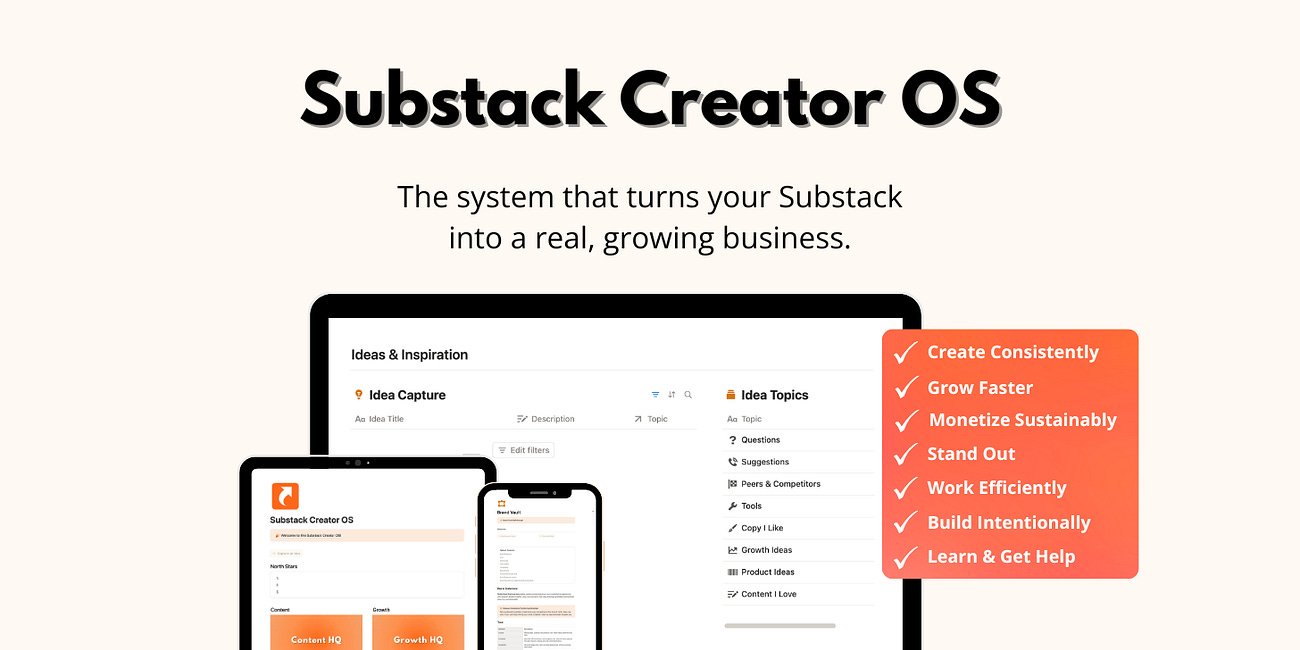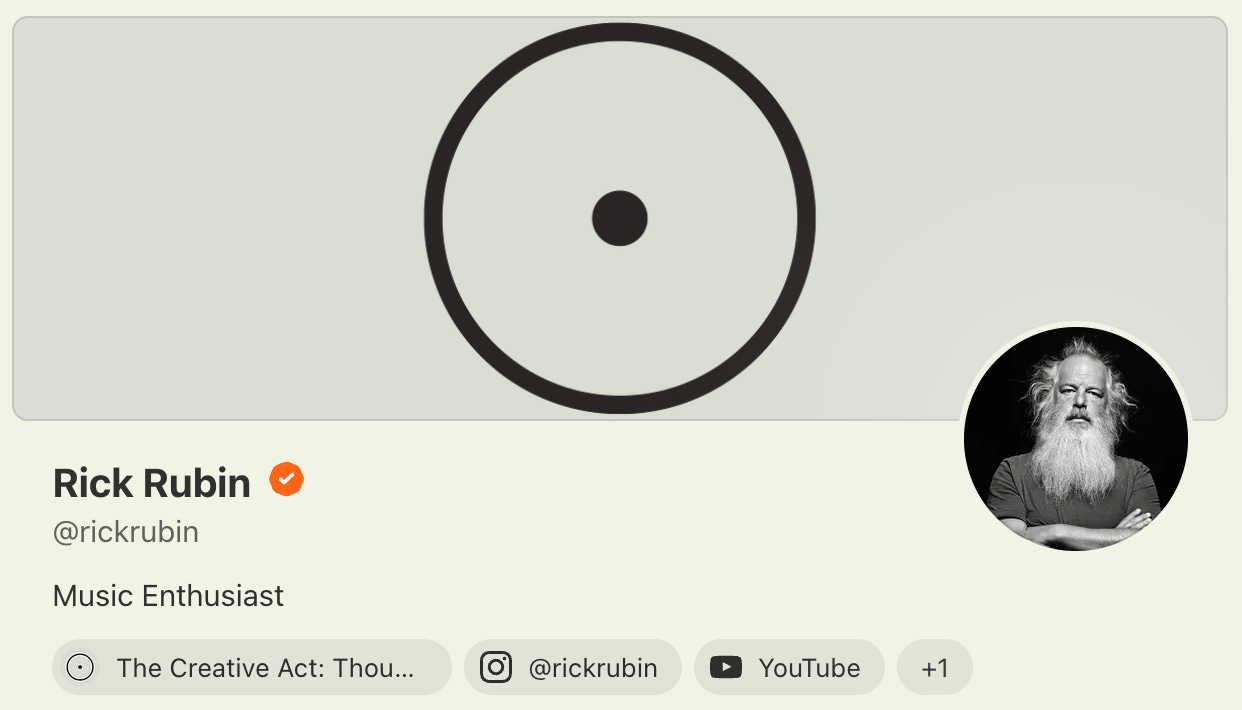Win Readers in 250 Words or Less: How to Nail Your Substack Author Bio
A step-by-step guide to crafting an author bio that sells your story and grows your Substack audience.
✨ New: The Substack Creator OS is here!
A complete Notion workspace for running and growing your Substack like a pro.
Publish more consistently with a streamlined content pipeline that eliminates chaos and guesswork.
Grow faster by turning your ideas, posts, and outreach into a clear, trackable growth system.
Increase your revenue with built-in tools for managing sponsors, products, and your paid subscriber strategy.
Right now, it’s free for Premium subscribers.
You only get one first handshake. On Substack, it’s your author bio: a small block of text that shows who you are, why readers should care, and if you’re worth subscribing to.
Most writers treat their bio like an afterthought; a quick line or two thrown together when they set up their account. But research shows that people form first impressions almost instantly. Studies of faces suggest judgments can happen in as little as 0.1 seconds, while eye-tracking research on websites shows impressions forming in under 0.2 seconds,1 and even as fast as 50 milliseconds.2 That means your Substack author bio needs to make an impact immediately.
Your author bio isn’t just filler. It’s a trust signal: a way to show you’re credible, approachable, and worth following. In other words, your bio can quietly influence whether a curious visitor becomes a loyal subscriber.
In this guide, I’ll break down exactly how to write a Substack author bio that works: short, clear, and compelling. By the end, you’ll have a version of your bio that’s no longer an afterthought but an effective tool to win readers in 250 words or less.
Table of Contents
Where Is Your Author Bio on Substack?
Your author bio can be discovered and surfaced in several places across the Substack platform.
Profile Page
Your author bio gets added and updated on your Substack profile page. Anytime someone visits your profile page, they will see your bio at the top.
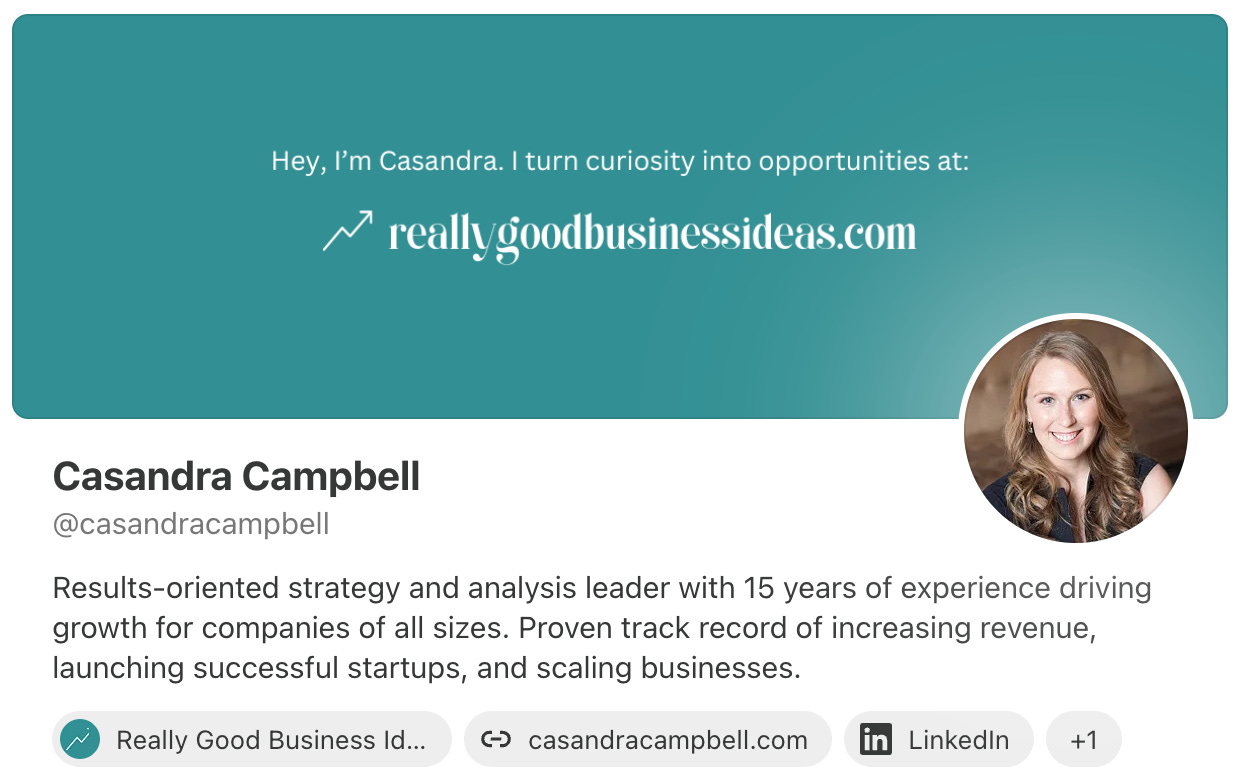
Notes Feed
One of the most common ways people discover new profiles is through the Substack Notes feed.
When you post a Substack Note, it can show up in the feeds of both your followers and non-followers who the algorithm thinks may be interested in your content. When someone sees a Note they like, they may hover over your name to learn more about you and either follow or subscribe. Your bio is one of the main pieces of information that will influence their conversion.
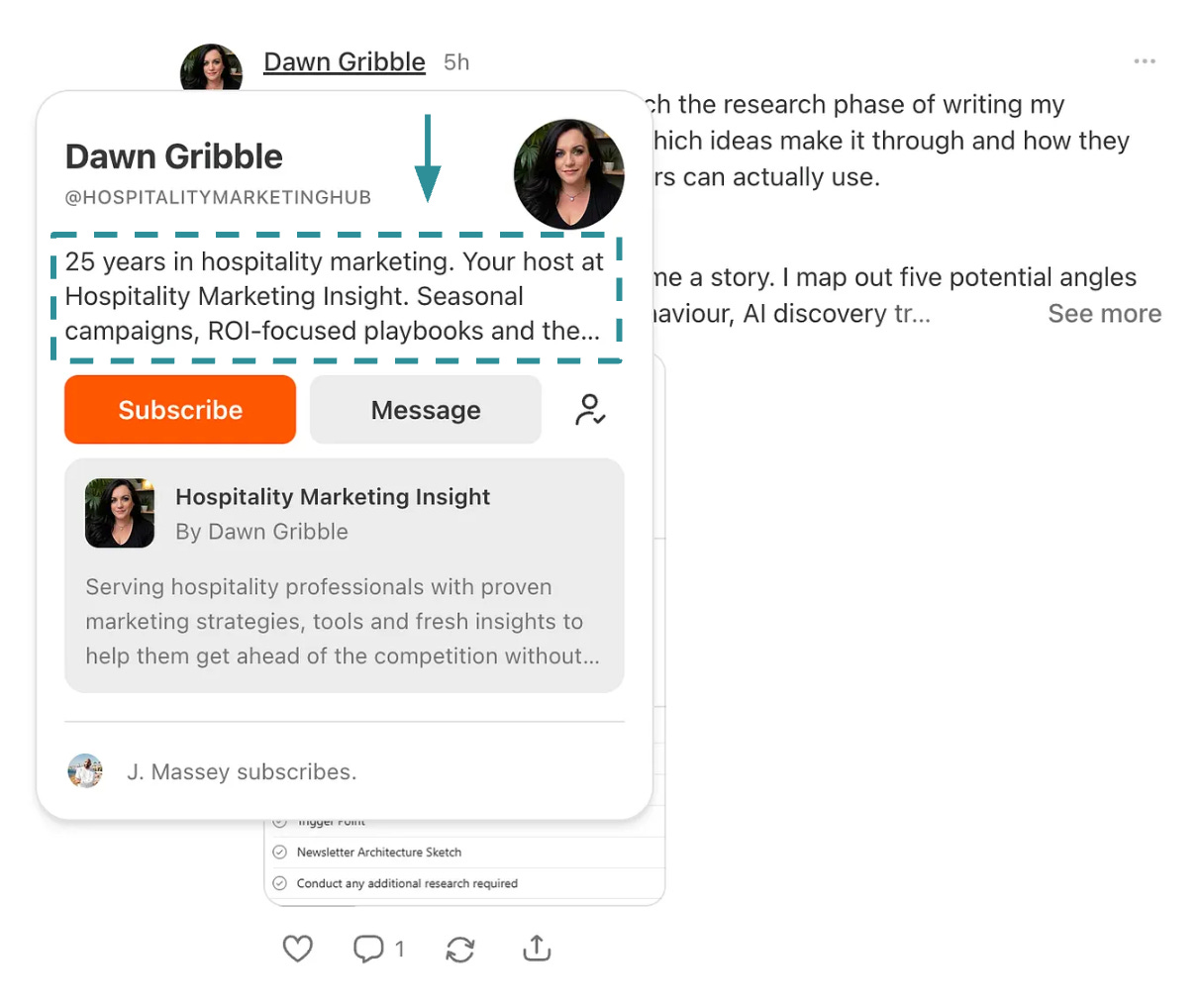
If you need an introduction (or a refresher) about Substack Notes, this guide is for you.
About Page
All of the contributing authors to a publication will automatically appear at the bottom of the publication’s About page under “People.” A small card will appear for each contributor’s profile, displaying their name, handle, photo, and (you guessed it) their bio.
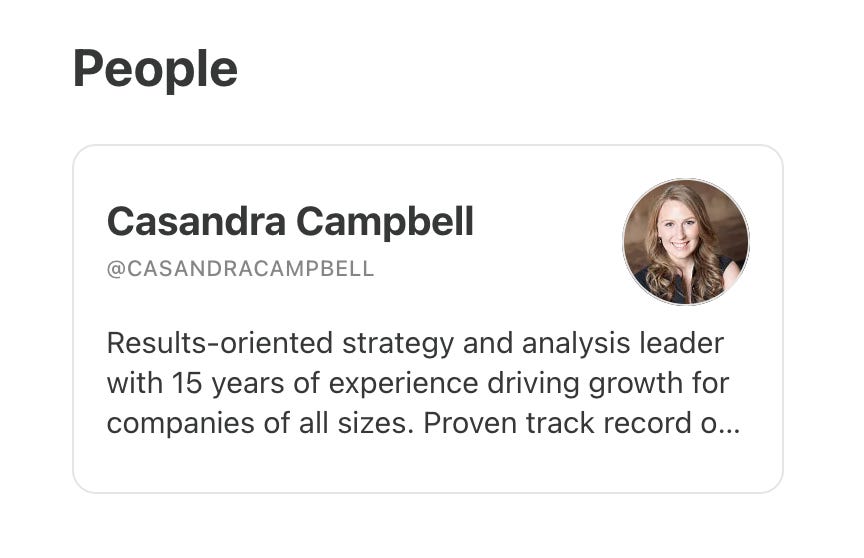
By the way, I have a guide to writing a high-converting About page if you need it!
Guest Posts
When you guest post on another publication, a small card will appear at the bottom of your post displaying your name, photo, bio, and a subscribe button, so a strong bio can really help drive subscriptions from your guest post.

How Long Should Your Substack Author Bio Be?
Your Substack author bio can be up to 250 words in length, but it’s important to know that not all 250 words will always appear. In many places, such as the Notes feed and in guest post author cards, your bio may be truncated. That means if your main hook is buried at the end, most people will never see it.
Keep your bio tight and front-loaded. Lead with who you are and what you write about.
Aim for a clear one-liner (for truncated views) with further info (100–250 words) for your profile page.
Don’t waste words on filler. Every sentence should either build trust or make the case for why someone should subscribe.
Core Elements of a Strong Substack Author Bio
A great author bio isn’t just about you, it’s about why you matter to your readers. To strike that balance, include three essential ingredients:
1. Who You Are
Share your expertise, credentials, or perspective in plain language.
Why: Research in persuasion shows that authority cues, things like your background, expertise, or achievements, build trust almost immediately. Models like the Elaboration Likelihood Model3 and the Yale Attitude Change Model4 show that people exposed to a credible or authoritative source are more likely to engage and believe the message.
Examples:
“As a former campaign strategist, I write about politics from someone who’s been in the room.”
“After 15 years in classrooms, I now help parents understand education policy in plain English.”
“My research on sleep has been featured in major publications, and I translate the science into practical tips.”
2. What You Write About (+ Why It Matters to the Reader)
Be clear about your topics and themes so readers know what to expect. But it’s not enough to list your topic; you need to frame it in terms of what the reader will get from subscribing. Your bio should answer the WIIFM question: “What’s in it for me?”
Why: Research shows people subscribe when they perceive a clear value exchange. Uses & Gratifications Theory5 explains that audiences commit to media when it fulfills a need or delivers a personal benefit. More recent studies confirm the same pattern online: subscription growth is strongest when value is communicated as a tangible benefit.67 In other words, people hit “subscribe” when they can instantly see why your writing will help, inform, or delight them.
Examples:
Too vague: “I write about marketing.”
Reader-framed: “I break down marketing so small business owners can win more customers without wasting money.”
Too vague: “I write about wellness.”
Reader-framed: “I share evidence-based wellness tips to help you feel calmer, sleep better, and avoid burnout.”
Too vague: “I write about books.”
Reader-framed: “I review books on creativity and productivity so you can find fresh ideas without drowning in reading lists.”
The difference is subtle but powerful: you’re not just describing your subject matter, you’re explaining its value to the reader.
3. A Touch of Personality
Add one small, memorable detail that makes you human: a tone choice, a hobby, or a surprising fact.
Why: Studies on persuasion and memory show that people remember specific, concrete details far better than abstract or generic claims. In classic memory research, Paivio’s Dual Coding Theory8 demonstrated that concrete words and images are easier to recall than vague or abstract concepts. More recent studies in consumer psychology confirm that when messages include distinctive, personal details, they are more memorable and persuasive.910
Examples:
“I cover the intersection of politics and culture. My newsletter is powered by equal parts coffee and Taylor Swift playlists.”
“I write about parenting and family life, from the trenches of raising twins and a very stubborn beagle.”
“I write about the future of work and how AI is reshaping careers. I also make a mean sourdough starter.”
The Science-Backed Substack Author Bio Formula
When we combine each of the three core elements, we have a simple formula that anyone can use to create a strong author bio.
Who you are + what you write about framed as a benefit + one human detail.When these three pieces are in place, your bio feels credible, relevant, and approachable; exactly the mix that makes readers want to stick around.
Author Bio Style & Tone: Match Your Publication
Your Substack author bio should sound like an extension of your newsletter. If your posts are conversational and funny, then a stiff, résumé-style bio will feel jarring. If your writing is data-heavy and serious, a quirky bio may undercut your authority.
Research on branding and trust shows that consistency across touchpoints (voice, visuals, tone) strengthens recognition and credibility. In marketing psychology, this is known as the congruence effect: when a brand’s tone matches across contexts, people perceive it as more authentic and trustworthy.11
Examples:
Finance newsletter (formal): “I’m a former hedge fund analyst writing about markets, investing strategies, and the behavioral psychology of money.”
Parenting newsletter (warm, conversational): “I share honest stories and practical tools for navigating parenthood—written between school drop-offs and late-night snack runs.”
Culture commentary (witty, playful): “I write about the absurd side of modern culture. Think memes, philosophy, and why everyone suddenly owns a Stanley tumbler.”
Read your last three posts. Would the same person who wrote them write your bio?
Common Author Bio Mistakes to Avoid
Even the most experienced writers struggle when it comes to bios. Here are the most common pitfalls, and how to avoid them:
1. Being Too Vague
Example: “I write about life, love, and ideas.”
Why It’s a Problem: If your bio could describe a hundred other newsletters, readers won’t remember you.
2. Overloading With Jargon or Job Titles
Example: “I am a synergistic strategist leveraging cross-functional frameworks in dynamic environments.” (LOL)
Why It’s a Problem: Jargon reduces comprehension and trust. Readers skim. If they don’t understand your bio instantly, they’ll move on.
3. Making It All About You (Instead of the Reader)
Example: “I’ve published three books, won awards, and spoken at dozens of conferences.”
Why It’s a Problem: Self-focused messages underperform compared to audience-focused ones. The WIIFM principle (“What’s in it for me?”) is what drives subscriptions.
4. Letting It Go Stale
Bios often get written once and never revisited. If your focus has shifted, or you’ve built new credibility, your old bio may be underselling you.
Why It’s a Problem: Outdated information signals neglect, not authority.
Quick Fix: Read your bio through the eyes of a first-time visitor. Is it clear, specific, and reader-focused? If not, it’s time for an update.
How to Test & Improve Your Bio
Your bio isn’t set in stone. Think of it as copywriting: the more you refine it, the better it performs. Here are simple ways to test and improve yours:
1. Get Reader Feedback
Ask a few subscribers or friends: “Does this make you want to subscribe?” If they can’t explain your newsletter back to you after reading your bio, it’s not clear enough.
Really Good Business Ideas Premium subscribers can also get feedback from me via Substack Chat or office hours appointments.
2. Try It In Different Contexts
Use your bio (or parts of it) in places where you already have an audience, like your Twitter profile, LinkedIn headline, or podcast description. Watch which version gets the most follows or engagement; that’s a signal of what works.
3. A/B Test Your Hook
You can’t a/b test your Substack author bio directly, but you can try different versions of your hook in Notes, social shares, or About sections. Compare which phrasing pulls more curiosity or subscribers.
4. Keep It Updated
Revisit your bio every 6–12 months. As your focus shifts or your credibility grows, update it so it matches where you are now. Your bio should evolve with you. Treat it as a living part of your publication, not a one-time setup step.
Your Substack author bio is more than a formality; it’s your first handshake with readers. In just a few lines, it communicates who you are, what you write about, and why your work matters to them. Done well, it builds trust, sparks curiosity, and turns casual visitors into subscribers.
The good news is that writing a strong bio isn’t complicated. Keep it short, specific, reader-focused, and true to the tone of your publication. Avoid the common mistakes, add a touch of personality, and don’t be afraid to refine it over time.
If you haven’t looked at your Substack bio in a while, now’s the time. Revisit it with fresh eyes and ask: Would this make me want to subscribe? And if the answer is no, you now know what to do.
To endless possibilities,
Casandra
Premium Bonus: Really Good Substack Bios Database
Want to see what a great author bio looks like in practice? I’ve built a database of hundreds of standout Substack bios across all categories: from finance to wellness to culture and more. Instead of starting from scratch, you’ll have a swipe file of examples to spark ideas.
And here’s the twist: the best examples aren’t just from the biggest publications. Big names don’t need a perfect bio; they’re already known. The real value is in studying smaller and mid-sized newsletters that use their bio strategically to hook new readers.
Rick Ruben, one of the most influential record producers of all time, can leave his bio as “Music Enthusiast”—you already know what you are going to get from someone of his stature. But if you’re reading this, you probably need your bio to work harder.
This bonus is available exclusively for Premium subscribers.



